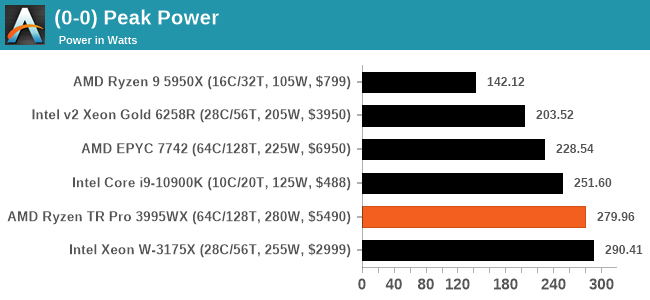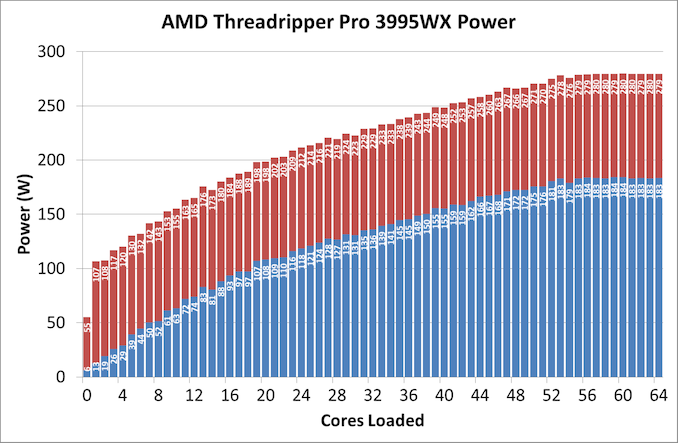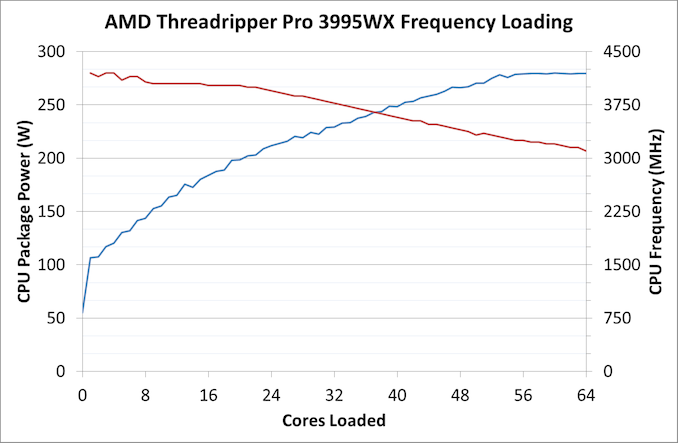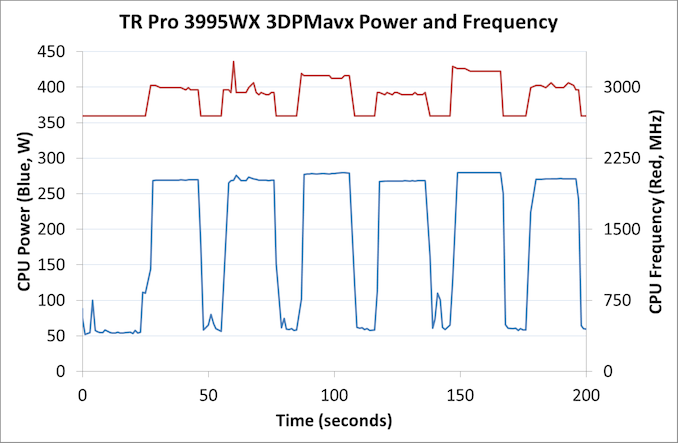64 Cores of Rendering Madness: The AMD Threadripper Pro 3995WX Review
by Dr. Ian Cutress on February 9, 2021 9:00 AM EST- Posted in
- CPUs
- AMD
- Lenovo
- ThinkStation
- Threadripper Pro
- WRX80
- 3995WX
Power Consumption
The nature of reporting processor power consumption has become, in part, a dystopian nightmare. Historically the peak power consumption of a processor, as purchased, is given by its Thermal Design Power (TDP, or PL1). For many markets, such as embedded processors, that value of TDP still signifies the peak power consumption. For the processors we test at AnandTech, either desktop, notebook, or enterprise, this is not always the case.
Modern high performance processors implement a feature called Turbo. This allows, usually for a limited time, a processor to go beyond its rated frequency. Exactly how far the processor goes depends on a few factors, such as the Turbo Power Limit (PL2), whether the peak frequency is hard coded, the thermals, and the power delivery. Turbo can sometimes be very aggressive, allowing power values 2.5x above the rated TDP.
AMD and Intel have different definitions for TDP, but are broadly speaking applied the same. The difference comes to turbo modes, turbo limits, turbo budgets, and how the processors manage that power balance. These topics are 10000-12000 word articles in their own right, and we’ve got a few articles worth reading on the topic.
- Why Intel Processors Draw More Power Than Expected: TDP and Turbo Explained
- Talking TDP, Turbo and Overclocking: An Interview with Intel Fellow Guy Therien
- Reaching for Turbo: Aligning Perception with AMD’s Frequency Metrics
- Intel’s TDP Shenanigans Hurts Everyone
In simple terms, processor manufacturers only ever guarantee two values which are tied together - when all cores are running at base frequency, the processor should be running at or below the TDP rating. All turbo modes and power modes above that are not covered by warranty. Intel kind of screwed this up with the Tiger Lake launch in September 2020, by refusing to define a TDP rating for its new processors, instead going for a range. Obfuscation like this is a frustrating endeavor for press and end-users alike.
However, for our tests in this review, we measure the power consumption of the processor in a variety of different scenarios. These include full AVX2/AVX512 (delete as applicable) workflows, real-world image-model construction, and others as appropriate. These tests are done as comparative models. We also note the peak power recorded in any of our tests.
AMD Ryzen Threadripper Pro 3995WX
The specifications for this processor list 64 cores running at a TDP of 280 W. In our testing, we never saw any power consumption over 280 W:

Going through our POV-Ray scaling power test for per-core consumption, we’re seeing a trend whereby 40% of the power goes to the non-core operation of the system, which is also likely to include the L3 cache.

Red = Full Package, Blue = CPU Core only (minus L3 we think)
We only hit the peak 280 W when we are at 56-core loading, otherwise it is a steady climb moving from 7 W/core in the early loading down to about 3 W/core when fully loaded. What this does for core frequencies is relatively interesting.
Our system starts around 4200 MHz, which is the rated turbo frequency, settling down to 4000-4050 MHz in that 8-core to 20-core loading. After 20 cores, it’s a slow decline at a rate of 25 MHz per extra core loaded, until at full CPU load we observe 3100 MHz on all cores. This is above the 2700 MHz base frequency, but also comes out to 2.86 W per core in CPU-only power, or 4.37 W per core if we also include non-CPU power. Note that non-CPU power in this case might also include the L3.
For an actual workload, our 3DPMavx test is a bit more aggressive than POV-Ray, cycling to full load for ten seconds for each of its six algorithms then idling for a short time. In this test we saw idle frequencies of 2700 MHz, but all-core loading was at least 2900 MHz up to 3200 MHz. Power again was very much limited to 280 W.












118 Comments
View All Comments
Holliday75 - Friday, February 12, 2021 - link
Oxford Guy: I just want to argue.Spunjji - Thursday, February 11, 2021 - link
They're a professional, they don't care about the name - that was the rebuttal, and it directly addressed your "claim". It doesn't need to be more than their opinion, because your "claim" was just your own turgid opinion.Pseudo-rationalists are a plague.
Oxford Guy - Thursday, February 11, 2021 - link
Another comment that fails to rebut the original claim.grant3 - Friday, February 12, 2021 - link
An industry professional, in the target market for this product, tells you "The name is stellar."Yes, that both addresses + contradicts your claim that you know what inspires "professional confidence" better than the actual professionals.
Spunjji - Thursday, February 11, 2021 - link
p r o f e s s i o n a lSome professionals are gamers. Some have a sense of humour. Some even make games!
But sure, it's not "Xeon", which is "professional" by virtue of being duller than a water flavoured lollipop.
Oxford Guy - Thursday, February 11, 2021 - link
The obsession continues...Qasar - Thursday, February 11, 2021 - link
and its your obsession. nothing wrong with the name threadripper. you want to complain about product names, go look at some names for video cards, or even some motherboards.hmm maybe you dont like the name cause intel didnt make it ?
schujj07 - Thursday, February 11, 2021 - link
Xeon is an even number name than Threadripper of Epyc. The name is too close to Xenon the Nobel gas. If you just heard the name you would think the Intel CPU doesn't play well with anything besides itself.schujj07 - Thursday, February 11, 2021 - link
*dumber not number...stupid autocorrectGeoffreyA - Friday, February 12, 2021 - link
For my part, I think Threadripper is a pretty nice name and have always liked it (it gives the impression of tearing through work with mighty, relentless threading). But I also agree with Oxford Guy's sentiment that names in computing are often made in poor taste (Bulldozer, Netburst, and Core 2 Duo are "choice" specimens). A subjective thing, to be sure, but that's how I feel.